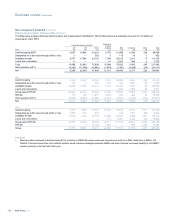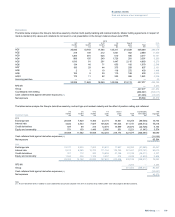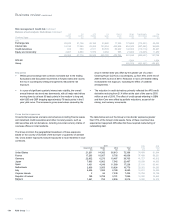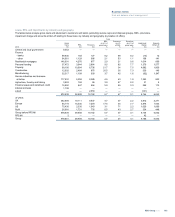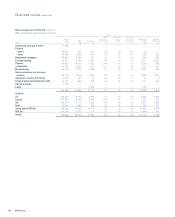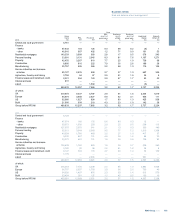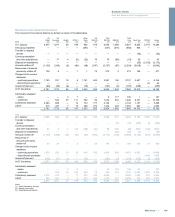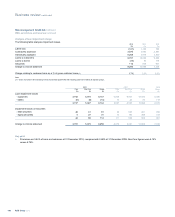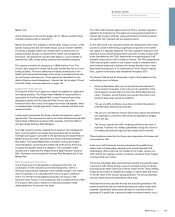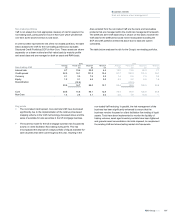RBS 2010 Annual Report Download - page 190
Download and view the complete annual report
Please find page 190 of the 2010 RBS annual report below. You can navigate through the pages in the report by either clicking on the pages listed below, or by using the keyword search tool below to find specific information within the annual report.Risk management: Credit risk continued
REIL, provisions and reserves continued
Impairment loss provision methodology
Provisions for impairment losses are assessed under three categories:
xIndividually assessed provisions: provisions required for individually
significant impaired assets which are assessed on a case by case
basis, taking into account the financial condition of the counterparty
and any guarantee and other collateral held after being stressed for
downside risk. This incorporates an estimate of the discounted value
of any recoveries and realisation of security or collateral. The asset
continues to be assessed on an individual basis until it is repaid in
full, transferred to the performing portfolio or written-off;
xCollectively assessed provisions: provisions on impaired credits
below an agreed threshold which are assessed on a portfolio basis,
to reflect the homogeneous nature of the assets, such as credit
cards or personal loans. The provision is determined from a
quantitative review of the relevant portfolio, taking account of the
level of arrears, security and average loss experience over the
recovery period. It incorporates loss experience adjustments, where
appropriate, in the light of current economic and credit conditions.
These include review of current cash collections profile performance
against historic trends, updates to metric inputs - including model
recalibrations and monitoring of operational processes used in
managing exposure - including the time taken to process non-
performing exposures; and
xLatent loss provisions: provisions held against impairments in the
performing portfolio that have been incurred as a result of events
occurring before the balance sheet date but which have not been
identified at the balance sheet date. The Group has developed
methodologies to estimate latent loss provisions that reflect:
–historical loss experience adjusted where appropriate, in the light
of current economic and credit conditions; and
–the period (‘emergence period’) between an impairment event
occurring and a loan being identified and reported as impaired.
xRecoverable cash flows or proceeds are estimated using two
parameters: loss given default (LGD) - this is the estimated loss
amount, expressed as a percentage, that will be incurred if the
borrower defaults; and the probability that the borrower will default
(PD).
xEmergence periods are estimated at a portfolio level and reflect the
portfolio product characteristics such as a coupon period and
repayment terms, and the duration of the administrative process
required to report and identify an impaired loan as such. Emergence
periods vary across different portfolios from 2 to 225 days. They are
based on actual experience within the particular portfolio and are
reviewed regularly.
xThe Group's retail business segment their performing loan books
into homogenous portfolios such as mortgages, credit cards or
unsecured loans, to reflect their different credit characteristics.
Latent provisions are computed by applying portfolio-level LGDs,
PDs and emergence periods. The wholesale calculation is based on
similar principles but there is no segmentation into portfolios: PDs
and LGDs are calculated on an individual basis.
xOnce a loss event has occurred, a loan is assessed for an
impairment provision. In the case of loans that are restructured due
to the financial condition of the borrower, the loss event and
consequent loan impairment provision assessment (based on
management’s best estimate of the incurred loss) almost invariably
take place prior to the restructuring. The quantum of the loan
impairment provision may change once the terms of the
restructuring are known resulting in an additional provision charge or
arelease of provision in the period in which the restructuring takes
place.
Provisions and AFS reserves
The Group's consumer portfolios, which consist of high volume, small
value credits, have highly efficient largely automated processes for
identifying problem credits and very short timescales, typically three
months, before resolution or adoption of various recovery methods.
Corporate portfolios consist of higher value, lower volume credits, which
tend to be structured to meet individual customer requirements.
Provisions are assessed on a case by case basis by experienced
specialists with input from professional valuers and accountants. The
Group operates a transparent provisions governance framework, setting
thresholds to trigger enhanced oversight and challenge.
Analyses of provisions are set out on page 189.
Available-for-sale financial assets are initially recognised at fair value plus
directly related transaction costs and are subsequently measured at fair
value with changes in fair value reported in owners’ equity until disposal,
at which stage the cumulative gain or loss is recognised in profit or loss.
When there is objective evidence that an available-for-sale financial asset
is impaired, any decline in its fair value below original cost is removed
from equity and recognised in profit or loss.
Impairment losses are recognised when there is objective evidence of
impairment. The Group reviews its portfolios of available-for-sale financial
assets for such evidence which includes: default or delinquency in
interest or principal payments; significant financial difficulty of the issuer
or obligor; and it becoming probable that the issuer will enter bankruptcy
or other financial reorganisation. However, the disappearance of an
active market because an entity’s financial instruments are no longer
publicly traded is not evidence of impairment. Furthermore, a downgrade
of an entity’s credit rating is not, of itself, evidence of impairment,
although it may be evidence of impairment when considered with other
available information. A decline in the fair value of a financial asset below
its cost or amortised cost is not necessarily evidence of impairment.
Determining whether objective evidence of impairment exists requires the
exercise of management judgment. The unrecognised losses on the
Group’s available-for-sale debt securities are concentrated in its portfolios
of mortgage-backed securities. The losses reflect the widening of credit
spreads as a result of the reduced market liquidity in these securities and
the current uncertain macroeconomic outlook in the US and Europe. The
underlying securities remain unimpaired.
Analyses of AFS debt securities and related AFS reserves are set out on
pages 191 and 192.
RBS Group 2010188
Business review continued


